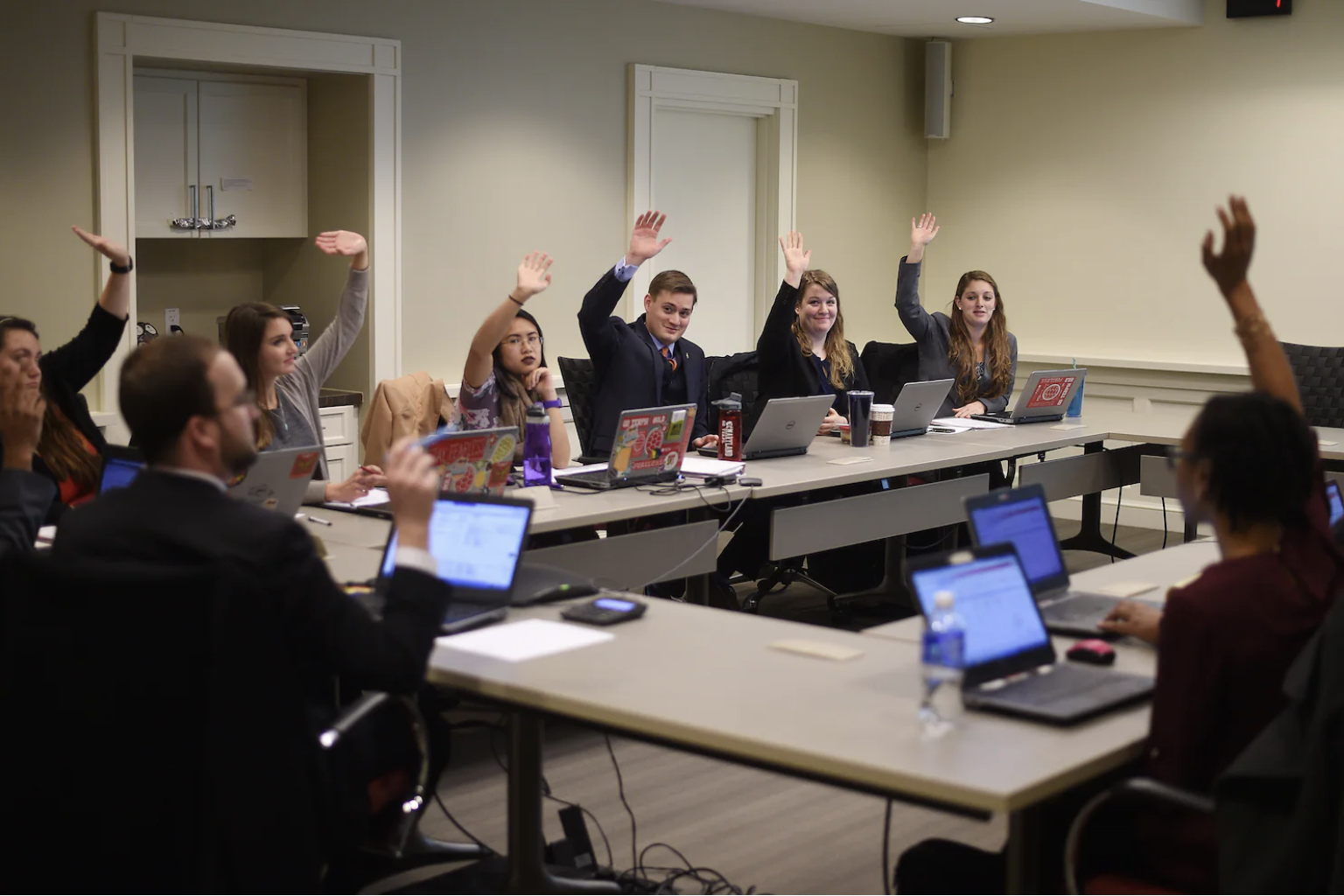Now that you’ve learned what happens to your application after you submit it, it’s time to dive into the next phase of the process: admission committees. What are they? How do they work? What factors influence the final outcome of your application? Let’s dive in!
What Are Admission Committees?
Committees are an evaluation tool that colleges and universities use to determine which applicants they will ultimately admit, defer/waitlist, or deny. First, let’s break down each of these possible outcomes:
Possible Admission Decisions
Admit: Congratulations! You have earned a spot at this college. If you applied ED, then you’re required to enroll here and attend. If you applied EA or Regular, then you have until May 1 to either accept or decline the college’s offer of admission.
Defer: This result occurs only during the ED/EA application rounds; it means your application is strong, but the admissions office wants to review it again in the context of all applicants. You’ll receive a final decision (admit, waitlist, or deny) at the same time as the Regular Decision applicants.
Waitlist: The cousin of the deferral, waitlisting occurs only during the Regular round (except in very rare circumstances). Similar to deferral, it means your application is strong, but the admissions office chose to prioritize other applicants. You may still get an offer of admission after the May 1 deadline, but chances are very slim.
Last year, Georgetown admitted 29 of their 2,543 waitlisted students (1%); Boston College admitted only 13 of 8,019 (0.2%).
Deny: “We regret to inform you…” This one is pretty straightforward. It’s tough, but you’re not alone! Take comfort in knowing you gave it your best shot.
In the Early rounds in November, admission committees all across the country convene to determine who to admit, defer, or deny from their Early applicant pools. In February, they reconvene to make decisions about EDII and Regular applications.
From Reading to Committees to Decisions
Here’s where we pick up from our last post. Remember how your application was read by two different admissions officers, either individually or in a team?
As a result of their evaluation, your application has now been sorted into a bin. This next step varies from college to college, but we’ll use this example that Rice University shared at NACAC:
The three small circles represent the three bins your application could be sorted into after being read by the evaluation teams:
Selection Committee (or Full Committee) Bin: the strongest applicants that are most likely to be admitted
Pre-Committee (or Sub-Committee) Bin: applicants who are deemed qualified but are not immediately outstanding
Deny Bin: applicants deemed not qualified for admission
The bins are listed here from most desirable outcome on the top to least desirable outcome on the bottom. The rectangles with the final admission decisions are listed the same way. All applicants are reviewed at least once more, even those that start in the Deny Bin.
You’ll notice there are many pathways to getting deferred/waitlisted or denied, but only one way to get admitted: the Selection Committee.
While the simplest path to admission is to travel directly from the Evaluation Teams through the Selection Committee, that is not the only path.
You can see from the red lines that applications from Pre-Committee can be funneled up or down to either the Selection Committee or Deny Bin.
The gray lines show that even apps from the Deny Bin could, in theory, work their way into Pre-Committee, then subsequently Selection Committee. It is extremely rare for apps that start in the Deny Bin to make it to the Selection Committee, much less be admitted, but it can happen. More often, the apps that move up to the Selection Committee start in Pre-Committee.
Getting Through Committee
Let’s assume your application is strong. It’s been read twice and funneled into either the Pre-Committee or Selection Committee bin for further review. What happens next?
Committee Functions and Goals
An office’s various Pre-Committees (or Sub-Committees) are made up of small groups of admissions officers, usually three or four people. Pre-Committees meet to discuss applications alongside a select group of others that share similar traits, such as geographic location, intended major, personal background, and/or financial circumstances.
The Selection Committee (also called Full Committee) is where the entire admissions team gathers together to plead their final cases for each student and cast their final votes to determine who gets those coveted spots in the incoming class. At some colleges, the strongest applicants are automatically admitted and never even appear before the committee. At others, every single qualified applicant is discussed and voted upon. At highly selective and ultra selective schools, applicants are often reviewed in groups similar to those of their Pre-Committees.
If the college assigns territory managers (like Rice does), then your territory manager will present your application to the committee and advocate for the decision they think is best based on the context of the territory and the college’s priorities.
The focus and extent of Committees are determined through two main factors:
The selectivity of the institution
The institution’s enrollment priorities
Here are some examples of each factor at work:
Selectivity
Moderately selective colleges (40-60% acceptance rates) rarely use committees. Most of their admissions decisions are decided during the reading process, and only small numbers of “on-the-bubble” applications are flagged for committee review. They are then usually reviewed by several senior members of the team, who make the final decisions about each app.
Highly selective colleges (20-40% acceptance rates) tend to use general committee groups, such as geographic regions, varsity athletes, students of color, or perhaps a specialized major like music or architecture. The strongest applicants are then brought to the Selection Committee.
Ultra selective colleges (<20% acceptance rate) use extensive Pre-Committees to help them sort through the overwhelming number of qualified applicants in their pool. They continue to review applications in groups even in the Selection Committee.
Enrollment priorities
Harvey Mudd: As a STEM-focused liberal arts college, Harvey Mudd typically receives about twice as many applications from men as from women, but one of their priorities is to maintain a gender balance as close to 50/50 as possible. So they likely review male and female applicants in different Pre-Committees with different standards for admission. (In 2021, HMC admitted 16.1% of female applicants but only 6.9% of male applicants.)
University of Illinois Urbana-Champaign: UIUC is a very popular choice for aspiring computer scientists due to their Top 5 computer science program, but they also offer over 150 different majors across 11 academic communities. As such, computer science applicants are likely reviewed in different Pre-Committees with different admission standards than, say, art history or economics applicants. (The overall acceptance rate is 44.8%, but the computer science acceptance rate is a mere 6.7%.)
UCLA: As a state-funded institution, UCLA (and the rest of the UC campuses) are required to prioritize California residents over out-of-state and international applicants. Therefore, California residents, US out-of-state residents, and international students are all evaluated differently, likely in different Pre-Committees with different admission standards.
In the same vein, voting also works differently at each college. At some, you need only a simple majority of votes to pass into the admit pool. At others, there is a predetermined cutoff point that varies between groups. At many elite schools, you need a unanimous vote in order to be admitted.
How To Stand Out In Committee Review
The best way to stand out during committee review is to have a hook (or two!) in your application. A hook is something interesting and unique that showcases your personality, interests, goals, and/or background. This is why so many colleges ask you to write supplemental essays; they want to know who you are and how you will contribute to their campus.
So make your value clear to them! Make an impact in your community—this shows colleges that you’ll make an impact on theirs, too. Use your essays, activities, and interviews (if applicable) to showcase your unique experiences and interests.
In a committee full of straight-A students with 1500-1600 SATs, what makes you stand out are your unique quirks, passions, and goals. Put your best, most authentic self forward, and when you finally get that coveted acceptance, you’ll know it’s because the university values what you bring to the table. That’s the kind of school where you can thrive.
The Final Tweaks
By the end of the Selection Committee (which typically lasts anywhere from 2-5 weeks), your application has been read, reviewed and discussed at least twice, but more likely three or four or even five times. The fate of your application is essentially set in stone and your outcome (hopefully Admit!) sits in the admissions database, waiting to be released into your portal.
As our above graphic from Rice states, however, no decision is final until it is released. Even after the dust settles from all the reading and committee-ing, some final tweaks will be made to the admit pool. An influential school counselor may have a lengthy call with their territory manager; a previously admissible student may get reported for plagiarizing; the band director may insist at the last minute that she needs an oboe player (yes, that really happens).
Once decisions are released, they are final. Time to celebrate, or commiserate, and check out another of our helpful blog posts!
This post is Part 3 in our NACAC 2022 series. Check out Part 1, How Test-Optional Has Changed Application Review, and Part 2, Inside Admissions: What Happens To That Application You Just Submitted.



